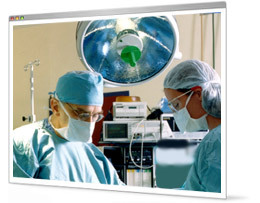My UPD8
You need to login before you download the free activities. To sign up click on join upd8 below.
Conjoined

Type: Activity
Learning Strategy: Scientific writing
Topic: Cell structure & function
Two year old Lakshmi was born with four arms and four legs and was at first thought to be a reincarnation of the Hindu Goddess of wealth after whom she is named. Life changing surgery has removed the extra limbs. But how could a child be born like this? In this activity students use the model of the dividing cell as the unit of life to answer this question. They produce a leaflet to show how fertilised eggs usually turn into a 4-limbed embryos and explain what made Lakshmi's body so different.
11-16 How Science Works:
Data, evidence, theories and explanations
1c Pupils should be taught how explanations of many phenomena can be developed using scientific theories, models and ideas.
Published: 26th November 2007
Reviews & Comments: 8
Learning objectives
Students learn how we can explain Lakshmi's unusual features by modelling embryo development as the division, growth and specialisation of cells.
Try the activity
- Activity sheet
Downloaded: 3255 times - Teachers Notes
Downloaded: 1853 times
You will need Acrobat Reader installed to open the activity sheets.
Curriculum link
11 – 14(KS3)Reproduction QCA 7B
• fertilized eggs divide into 2, 4, 8 etc to make a foetus.
• how identical and non-identical twins occur
GCSE specifications
AQA Additional B2 11.8
Edexcel Additional B2 Divide and Develop B2 2
OCR 21st Century Additional B5 Growth and Development B2 2
OCR Gateway Core B3: Living and Growing
Running the activity
Display page 1 to set the task. Students must prepare a leaflet to describe how fertilised eggs normally produce a fully-developed fetus and explain how Lakshmi got her extra arms and legs. Page 2 highlights the cell division and specialisation that underpins growth and shows how non-identical, identical and conjoined twins can form.
Other points that could be made are that a perfectly normal embryo will still form if one cell is removed at the 8 cell stage e.g. for pre-implantation genetic diagnosis. Cattle are routinely produced by collecting 8-cell embryos from the best parent animals, splitting the embryo and implanting the separate clones into surrogate cows. It is a criminal offence, punishable by up to 10 years in prison and an unlimited fine, to do this with human embryos.
Extension
A team of more than 30 surgeons took 27 hours to remove Lakshmi's parasitic twin and reshape her body. Her parents only earned 50p a day working as labourers but the operation cost around �100,000. It was done for free by the hospital in Bangalore. But would the money have been better spent treating 100's of other children with life-threatening diseases? The ethics involved in making that decision could be discussed in conjunction with the UPD8 ethics teaching tool - 'The Simpletons'.
Web links
News links
- Daily Mail
- Plenty of images and a brief account of the story.
- Digital Journal
- A condensed version of the story which includes a video.
- UIC
- Animations of normal embryonic development.
Media links
- Channel 4
- General information about conjoined twins.
Reviews & Comments
Write your online review to share your feedback and classroom tips with other teachers. How well does it work, how engaging is it, how did you use it, and how could it be improved?
Conjoined review
May 6th, 2009

Used with a year 7 class and simplified some of the information. They really enjoyed it and it raised some interesting ideas!
Reviewer: Louise Gadsby
Conjoined review
Mar 31st, 2009

I have used this resource several times with year 7 groups - all are really interested in Lakshmi and produce great posters/leaflets about the development of twins and how Lakshmi is 'different'.
Reviewer: Debbie Giles
Conjoined
Feb 11th, 2009

Running this activity as part of a lesson discussing stem cells and embryo development led to some of the most thoughtful discussion I have heard from a group of pupils.
Reviewer: Helen Block
Science KS3
Nov 13th, 2008

This activity is very good, but mainly suited to the high attaining scientists at KS3.
It is a very good activity for GSCE groups when the come to do work on the development of the foetus or genetic engineering.
A well thought through activity but the audience needs to be considered when doing it.
Reviewer: Niamh O' Neill
conjoined
Feb 2nd, 2008

I have introduced the activity to my year 7 students and they can't wait to do it
Reviewer: Friday Akpa
Conjoined review
Jan 11th, 2008

Had a superb lesson with my lower set year9, all were fully engaged and contributed to the discussions
Reviewer: BHAWANA SINGH
conjoined twins
Dec 12th, 2007

Excellent use of topical event to help understanding for ks4 students .
Students fascinated by event- would love an update when available to show progress of Lakshmi
Reviewer: Annette Taylor
Conjoined review
Dec 2nd, 2007

Cannot open the pdf file. will only save as html document. Help!
Reviewer: Linda Worrall

Related Activities
Biology / Cell structure & function
Biology / Reproduction
How Science Works / Theories & models
- CSI 5/11 - Murder in the Park re-published
- Global Warming Swindle
- Firstborns get the brains?
- Pomegranate ovary model
- Homeopathy: is it Science?
- CSI 5/11 - Murder in the Park
- Climate control
- So windy